The 10 most controversial record covers of all time
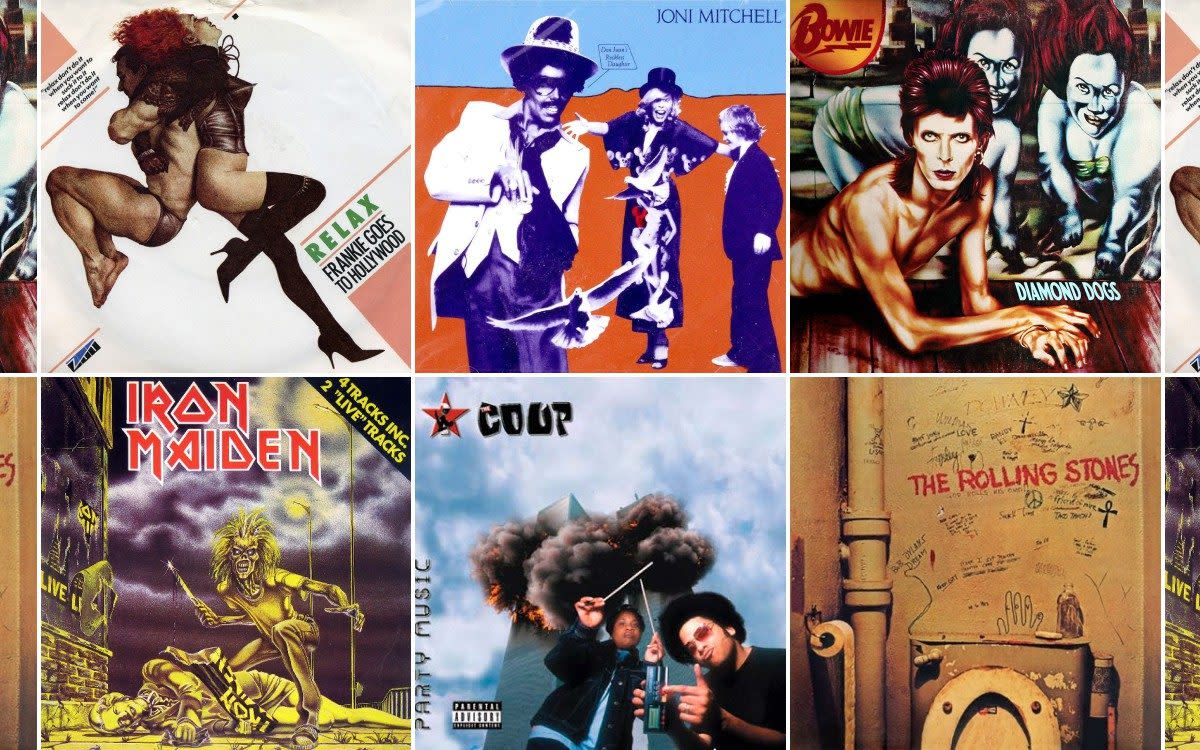
- Oops!Something went wrong.Please try again later.
Mercury-prize winning British rapper Skepta caused outrage recently when he revealed the cover art for his new single Gas Me Up (Diligent). The image showed a group of tightly-packed men with shaven heads, all seemingly wearing similar-coloured trench coats. On the back of one man’s head is tattooed the words “gas me up”. The picture immediately drew comparisons to the atrocities of the Holocaust. Skepta quickly apologised and said any connection was unintentional.
It was the latest in a long line of record sleeves that have caused controversy over the decades, either intentionally or not. It was 50 years ago that Roxy Music released their fourth album Country Life to howls of disapproval about the scantily clad models on the front. And it has been 40 years since Frankie Goes to Hollywood shocked the nation – and disgusted the BBC – with their debut single Relax.
These, then, are the 10 most controversial album or single sleeves of all time. Love them or loathe them, they all made an impression. Which, in the highly competitive world of selling records, may have been the point...
1. David Bowie, Diamond Dogs (1974)
David Bowie’s 1974 album was a collection of songs about a post-apocalyptic society populated by half-men-half-dogs. So, naturally, Bowie wanted to depict himself as one of his disturbing hybrids on its sleeve. Artist Guy Peellaert duly came up with an image which showed the top half of Bowie lying on the floor like a copper-haired Great Dane.
However when the album’s gatefold sleeve was unfolded, the full extent of Bowie’s dog-ness became clear in the unmistakable form of his canine genitalia. His record label RCA demanded that the offending parts were airbrushed out, much to Bowie’s chagrin. “It was a huge shouting match which they won on the simple determination that no record store would carry it,” the singer recalled in 2001. “They did in fact print quite a few with the aforesaid c---, but the US stores went ballistic as indeed RCA had predicted, so I let them do a reprint rather than lose the album completely.” For a while at least, Bowie really was the dog’s b–––––-s.

2. The Beatles, Yesterday and Today (1966)
In 1966 long-time Beatles photographer Robert Whitaker was as fed up with the Fab Four’s squeaky-clean image as the band themselves were. So at a London photoshoot that March, he gathered props including butchers’ smocks, a pig’s head, offal offcuts and pieces of children’s dolls. His ambitious idea was to create a triptych called Somnambulant Adventure that would stretch across two panels of an album cover.
It didn’t quite turn out like that. Rather, a picture of the band draped in meat became the cover of a US-only album called Yesterday and Today. The band said it was their comment on the Vietnam war. Capitol Records in the US sent out 60,000 promotional copies but recalled them almost immediately after an instant and fierce backlash. George Harrison later called the so-called Butcher Sleeve “gross” and “stupid”.
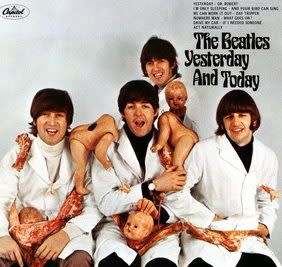
3. Roxy Music, Country Life (1974)
“I knew that pictures of pretty girls had been used to sell cars, soap and just about everything else. So why not rock music?” asked Bryan Ferry in the Seventies. All but one of Roxy Music’s eight studio albums therefore featured female models in varying states of undress on their sleeves. However Roxy’s fourth album Country Life caused an uproar. The cover was of two almost-naked German women, Contanze Karoli and Eveline Grunwald, who’d walked into a Portuguese bar where Ferry was drinking.
They were fans (and it transpired the pair were, respectively, sister and girlfriend of Can guitarist Michael Karoli). The shot was taken in darkness during an unplanned beach photo shoot. The pair’s nipples and pubic hair were visible through their underwear. The shot was meant to artfully pastiche the staid pictures of upmarket magazine Country Life. But many record retailers simply saw smut: US versions were initially sold in cloudy shrink wrap before the picture was binned altogether in favour of a close-up of the hedge behind the models.

4. Joni Mitchell, Don Juan’s Reckless Daughter (1977)
Joni Mitchell controversially donned blackface on the cover of this late-Seventies album. She’d first adopted the alter-ego of a black male pimp called Art Nouveau the year before for a fancy dress party. Her decision to appear as him on an album cover was a misguided attempt to make a point about identity.
Criticised in the male-dominated music press for being both “old” and somewhat free with her affections, this was her way of not having to be herself. Rather than being perceived as a meek and controlled woman, she could – dressed as Art – be a strong, powerful man who controlled women. But the well-intentioned comment on gender politics was in dubious taste. “Even in 1976 this caricature was outrageous and offensive,” historian Ken Padgett told the BBC in 2016.
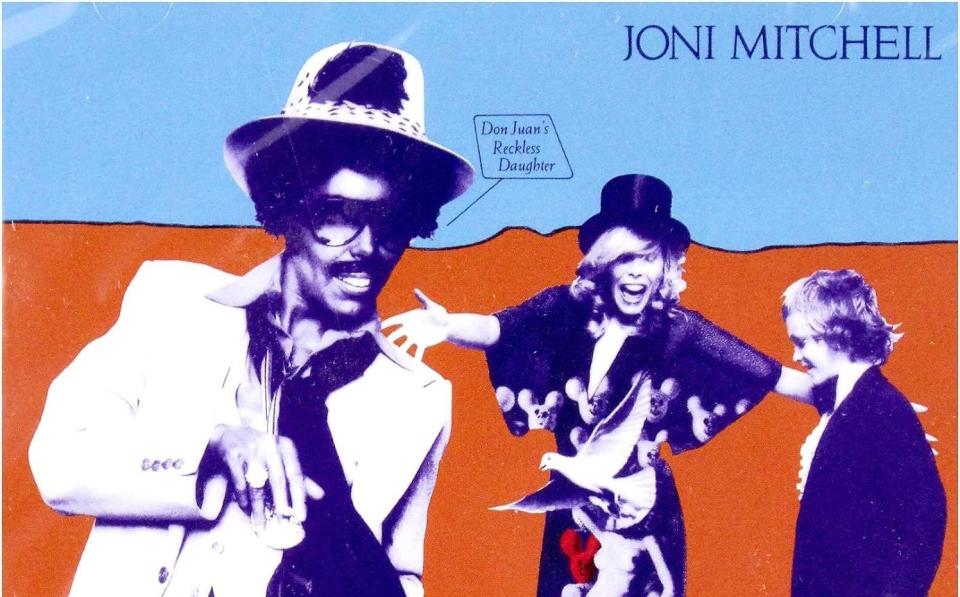
5. Frankie Goes to Hollywood, Relax (1984)
One of the most controversial record sleeves ever featured a one-time Mr Universe called Brian wearing leather pants, and a student called Caroline. Oh, and a printed lyric about ejaculation. Cue outrage. Radio 1 DJ Mike Read refused to play Relax by Liverpudlians Frankie Goes to Hollywood and the BBC banned the song, whose lyrics expanded on the themes covered on the sleeve.
The result – inevitably – was that the risqué slice of pop went to number one for five weeks almost exactly 40 years ago. The picture came from an illustration by artist Yvonne Gilbert that had appeared in the June 1983 edition of Men Only magazine. The back sleeve of the single featured a man in a toga having his nipple-ring pulled by a hand. “It’s hardly porn. I always thought my work was rather tasteful,” Gilbert told a Q magazine in 2001.
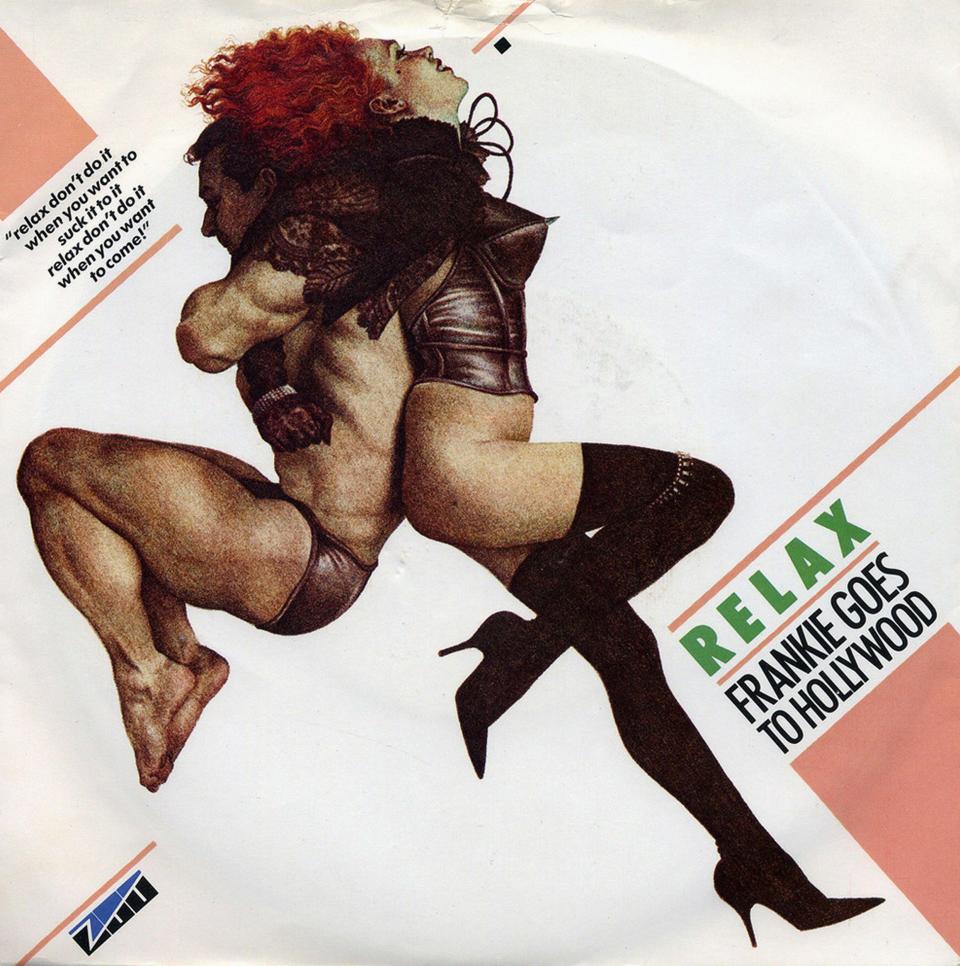
6. The Coup, Party Music (2001)
The cover design for the fourth album by American hip hop group The Coup was grimly prescient and swiftly replaced. In June 2001, a putative sleeve was designed of Coup duo Boots Riley and Pam the Funkstress standing in front of New York’s World Trade Centres and appearing to press a button on a detonator device. Behind them, the twin towers explode into flames. The album, which was due to be released in September 2001, was delayed for two months following the September 11 attacks so a new cover could be designed.
“This was done long ago and never meant to be any literal interpretation of any event,” the band’s label boss said. On closer examination, the ‘detonator device’ turned out to be an electronic tuner, while one of the band members waved a pair of conductor’s batons. It was, said Riley, “supposed to be a metaphor for the capitalist state being destroyed through the music.” Better to have erred on the side of caution on this one, I think.

7. The Rolling Stones, Beggars Banquet (1968)
The Andy Warhol-conceived ‘crotch with a zip’ cover for 1971’s Sticky Fingers may be more famous, but the Rolling Stones’ most shocking album cover adorned their Beggars Banquet LP three years earlier. It consisted of a photograph of a filthy lavatory with soiled toilet paper dangling from a holder and its wall scrawled in graffiti. Bon mots included “Wot no paper!”, “Music from big brown” (a scatological parody of The Band’s Music from Big Pink album, released that year) and “Marahishi was here” (a misspelt dig at The Beatles’ White Album, which was partially written at Maharishi Mahesh Yogi’s ashram in India and also came out in 1968). It was “a real funky cover,” Keith Richards said.
Record company Decca didn’t think so: they were appalled and refused to release the album, leading to months of delay. It was eventually replaced by a simple and stylish invitation in old-fashioned copperplate script, with R.S.V.P. in the bottom left corner, as though we’d all been invited to Mick n’ Keef’s transgressive soiree.
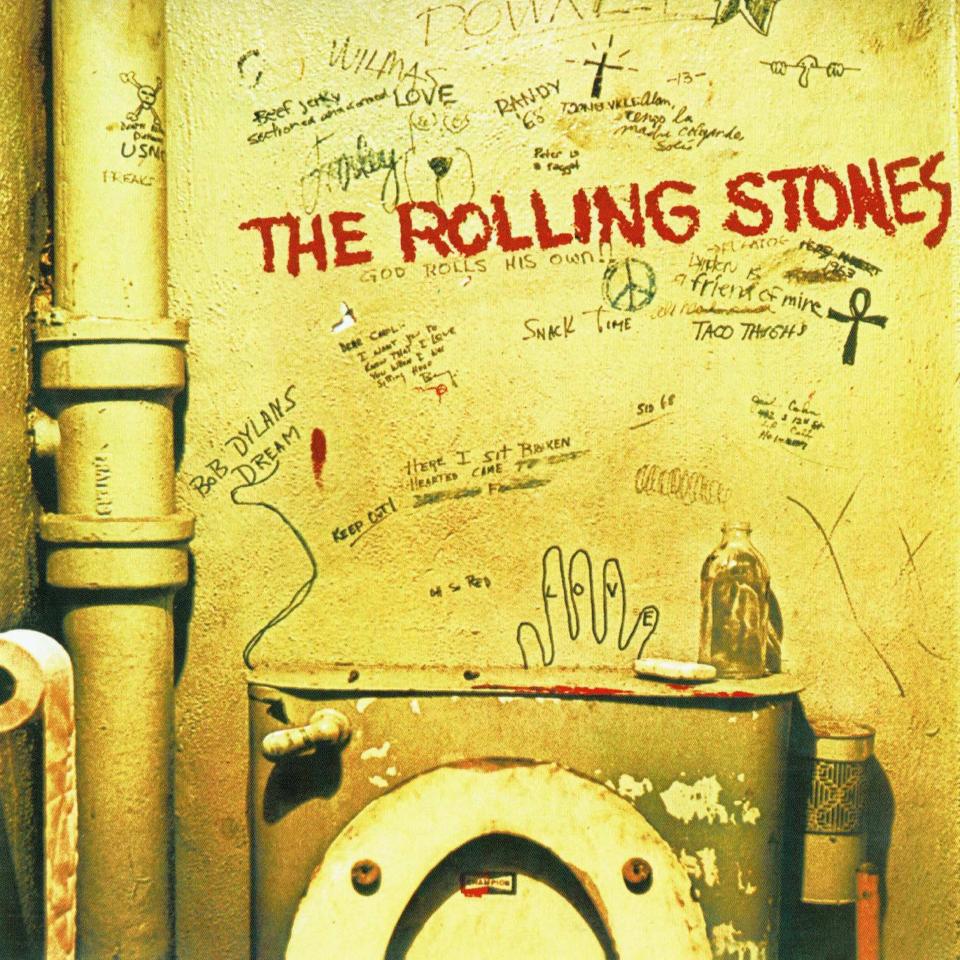
8. The Durutti Column, The Return of the Durutti Column (1980)
“Had Factory Records existed now you could quite credibly give it the Turner Prize,” Factory’s erstwhile sleeve designer Peter Saville once told me. This gimmicky slice of creative genius from the Manchester label’s post-punk Situationist group The Durutti Column was a case in point – and it had the desired effect of annoying almost everyone who bought the record.
In making their LP sleeve out of sandpaper, the band figured their album would scratch any record or sleeve that came into contact with it on a shelf. They’d literally destroy the competition. So Factory boss Tony Wilson bought 4,000 12-inch squares of sandpaper and tasked label-mates Joy Division with glueing them onto record sleeves. Everyone hated it. The sandpaper tore other records as well as retailers’ cellophane coverings, while the glue buckled thereby warping any records that were packed tightly next to it.

9. Iron Maiden, Sanctuary (1980)
Heavy metal band Iron Maiden alighted on quite a concept for the cover of their second single Sanctuary. The story behind the image – and bear with me here – goes like this: then-Prime Minister Margaret Thatcher walks down a dystopian street at night and tears an Iron Maiden poster off a wall, only for the band’s zombie mascot Eddie to appear out of nowhere and stab the PM in the back. The band insisted that the picture was meant to be a play on her nickname the Iron Lady (or “Maiden” – geddit?).
The band’s formidable manager Rod Smallwood then suggested to label EMI that they place a small black rectangle over Thatcher’s eyes to make it look as though the image had been censored (even though it was perfectly clear from her hairdo and pussybow blouse that it was her). He figured they’d get more publicity this way. And guess what? The tabloids were all over it. Thatcher got her revenge, mind. The sleeve of follow-up single Women in Uniform saw her ambush an unsuspecting Eddie with a machine gun.
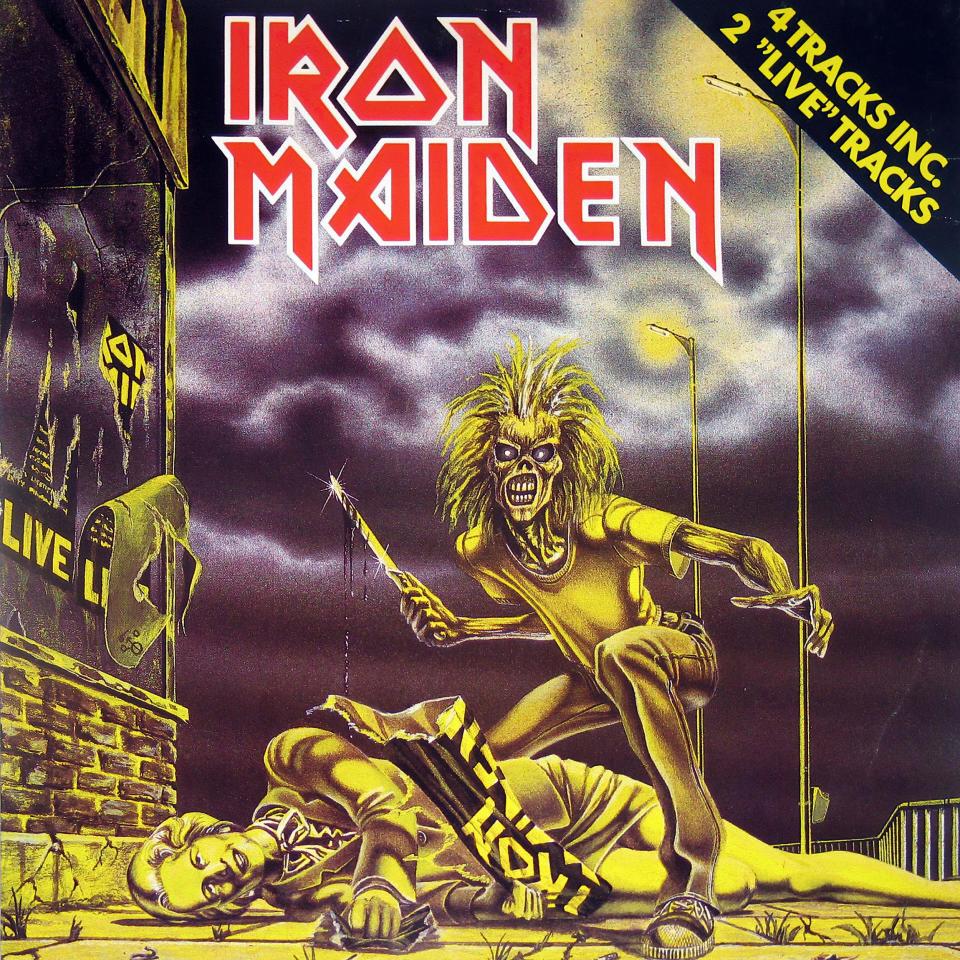
10. Add N To [X], On the Wires of our Nerves (1998)
Electronic group Add N To [X] had a novel vision for the cover of their second album: let’s show band member Ann Shenton giving birth to a Moog synthesizer via caesarean section. The idea was that Shenton had made love to the machine and that this was the result. “We were all getting interested in the link between the biological and synthetic,” bandmate Steve Claydon explained soon after.
The picture, which brings to mind the monster popping out of John Hurt’s stomach in Alien, was taken by artist Simon Periton in a photo lab at St Martin’s College. The fake stomach flesh was a cross between plastic and tissue and was made by a friend who was a make-up artist on films.

